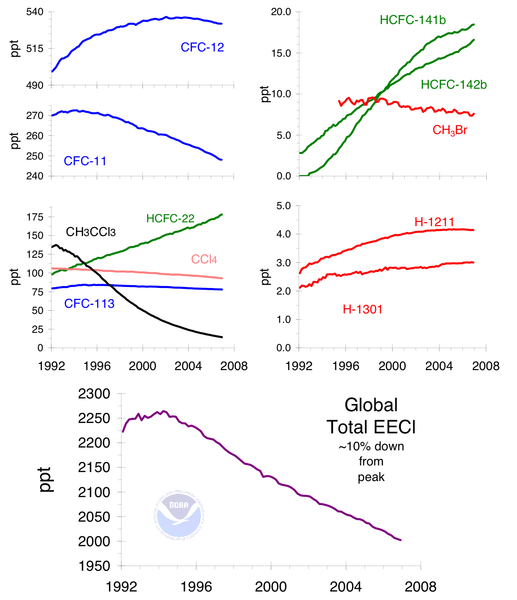ચિત્ર:Ozone cfc trends.png

આ પૂર્વાવલોકનનું કદ: ૫૧૭ × ૬૦૦ પિક્સેલ. અન્ય આવર્તનો: ૨૦૭ × ૨૪૦ પિક્સેલ | ૪૧૪ × ૪૮૦ પિક્સેલ | ૬૬૨ × ૭૬૮ પિક્સેલ | ૧,૦૯૬ × ૧,૨૭૧ પિક્સેલ.
મૂળભુત ફાઇલ (૧,૦૯૬ × ૧,૨૭૧ પીક્સલ, ફાઇલનું કદ: ૧૨૩ KB, MIME પ્રકાર: image/png)
ફાઇલનો ઇતિહાસ
તારીખ/સમય ઉપર ક્લિક કરવાથી તે સમયે ફાઇલ કેવી હતી તે જોવા મળશે.
| તારીખ/સમય | લઘુચિત્ર | પરિમાણો | સભ્ય | ટિપ્પણી | |
|---|---|---|---|---|---|
| વર્તમાન | ૦૩:૩૦, ૩ ઓક્ટોબર ૨૦૧૬ |  | ૧,૦૯૬ × ૧,૨૭૧ (૧૨૩ KB) | Cmdrjameson | Compressed with pngout. Reduced by 46kB (27% decrease). |
| ૦૯:૪૧, ૬ ઓક્ટોબર ૨૦૦૯ |  | ૧,૦૯૬ × ૧,૨૭૧ (૧૬૯ KB) | Robert Skyhawk | Updated information current to 2008. Upload requested by English Wikipedia user Tobus2 via Images for Upload. | |
| ૦૧:૦૮, ૧૬ જાન્યુઆરી ૨૦૦૬ |  | ૧,૧૩૯ × ૧,૫૭૭ (૨૪ KB) | Maksim | La bildo estas kopiita de wikipedia:en. La originala priskribo estas: CFC gas trends and equivalent chlorine effect. Combined chlorine and bromine in the lower stratosphere (10-25 km), where most ozone loss occurs, leveled off around [ |
ફાઇલનો વપરાશ
આ ફાઇલ માં નીચેનું પાનું વપરાયેલું છે:
ફાઇલનો વ્યાપક ઉપયોગ
નીચેની બીજી વિકિઓ આ ફાઈલ વાપરે છે:
- bg.wikipedia.org પર વપરાશ
- ca.wikipedia.org પર વપરાશ
- el.wikipedia.org પર વપરાશ
- en.wikipedia.org પર વપરાશ
- eo.wikipedia.org પર વપરાશ
- es.wikipedia.org પર વપરાશ
- eu.wikipedia.org પર વપરાશ
- fi.wikipedia.org પર વપરાશ
- fr.wikipedia.org પર વપરાશ
- hi.wikipedia.org પર વપરાશ
- id.wikipedia.org પર વપરાશ
- kn.wikipedia.org પર વપરાશ
- pt.wikipedia.org પર વપરાશ
- simple.wikipedia.org પર વપરાશ
- ta.wikipedia.org પર વપરાશ
- zh.wikipedia.org પર વપરાશ




